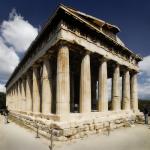|
This section contains 3,287 words (approx. 11 pages at 300 words per page) |

|
Background.
The Hellenistic period spans the years from the death of Alexander the Great in 323 to 30 B.C.E., when Rome annexed the last independent Hellenistic kingdom, Egypt, which was ruled by a royal dynasty that was descended from one of Alexander's generals, Ptolemy. The year 30 B.C.E. does not mark a sharp break in the artistic tradition. Athens maintained its reputation as a center for the visual arts, but it was now only one of many. The world of the Greek artist expanded enormously. This period of artistic development was ushered in by Alexander's favorite sculptor Lysippus of Sicyon. He was not the first to portray figures in motion, but he was the first to make them fully three-dimensional. Yet there is a rational organization to their composition which Lysippus inherited from the classical age and passed on to his successors. Sculptors...
|
This section contains 3,287 words (approx. 11 pages at 300 words per page) |

|




